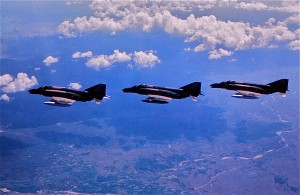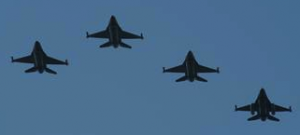This site conceptually joins the words “aviator” and “writer” with an essential fighter pilot skill: formation flying.
 Of all the differences between civilian and military aviation, the intentional act of reducing the distance between airplanes to a few feet is without question one of the most significant. This is not to say that civilian pilots don’t fly in formation, because they most certainly do. The key distinction, however, is that of purpose, because I’m not talking about the exotic show formations of demonstration teams.
Of all the differences between civilian and military aviation, the intentional act of reducing the distance between airplanes to a few feet is without question one of the most significant. This is not to say that civilian pilots don’t fly in formation, because they most certainly do. The key distinction, however, is that of purpose, because I’m not talking about the exotic show formations of demonstration teams.
Practical demands of daily operations force military aircraft into close proximity, which fundamentally changes the risks already inherent in the profession. During my career, the statistical reality was this: 85% of all mid-air collisions occurred between members of the same flight. Making light of the danger, fighter pilot jargon typically referred to any formation flying as, “Same way, same day.” There’s a lot more to it, of course. To illustrate the significance of formation to my blog, I’ll use the most common variation, called “fingertip.”
 Reference either hand with the fingers extended and together, the tips represent the relative positions of each member of a four-ship formation flight: the middle finger is #1 (the flight leader); the index finger is #2 (a wingman); the third finger is #3 (the element leader), and the pinkie (although no fighter pilot would ever call it that) is #4 (also called a wingman). Split into two parts, the four-ship formation becomes two elements, each with a leader and a wingman.
Reference either hand with the fingers extended and together, the tips represent the relative positions of each member of a four-ship formation flight: the middle finger is #1 (the flight leader); the index finger is #2 (a wingman); the third finger is #3 (the element leader), and the pinkie (although no fighter pilot would ever call it that) is #4 (also called a wingman). Split into two parts, the four-ship formation becomes two elements, each with a leader and a wingman.
I have established seven post “logbooks” within this blog to illustrate the underlying concept that captures the differences in the subject matter I use to write the posts. Please see the Blog and Logbook Pages for an explanation of each.



4 Responses to Formation (doing it together)